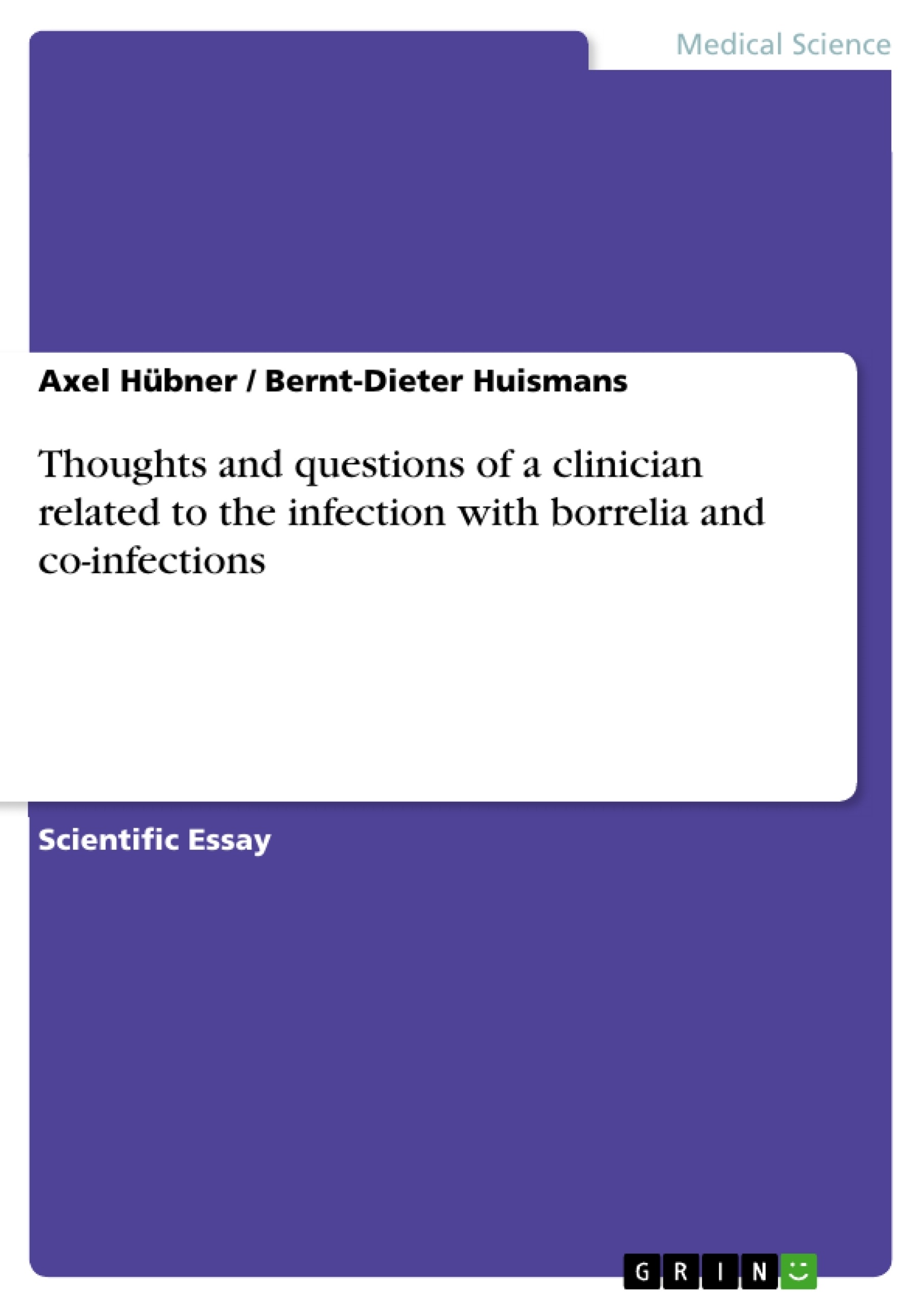Handling patients with possible Lyme disease and co-infections in clinic and practice, the author reflects on the justifications of his actions as he is constantly drawn into the discussion between theoreticians and practitioners. The representatives of these two opposing camps are organised by the IDSA (Infectious Disease Society of America) and the corresponding European organisations such as EUCALB (European Union Concerted Action on Lyme Borreliosis) on the one hand, and the ILADS (International Lyme and Associated Diseases Society) and the DBG (Deutsche Borreliose Gesellschaft) on the other hand.
As a clinician that the author is, who witnesses the suffering of his patients on a daily basis, he appeals for the collaboration of all parties involved. He asks questions about the infection with borrelia, the possibility of a chronic Lyme disease, the existence of chronic infections generally in patients with weaker immune systems, the symptoms of an infection with borrelia (of different strains) and other tick-borne diseases, the sensitivity and specificity of the determination of antibodies in the everyday practice, the validity of EliSpot and the CD57 values for diagnosis, the treatment with antibiotics, the measures to control and support the patient's metabolism (adjuvants) before and during treatment, the phenomenon of erythema migrans, the biofilms that are complicating treatment and the other phenomenon of pleomorphic, slowly growing bacteria types (so called persister forms and L-forms) that may cause possible relapses.
This contribution relies on a thorough study of literature. You will find a comprehensive list of references and links in the annex to prompt and inspire every reader interested in this topic. The author shares his thoughts and questions with the only purpose to stimulate factual discussions.
Inhaltsverzeichnis (Table of Contents)
- Abstract / Summary.
- Index of tables.
- General information:………………..\n
- Does chronic Lyme exist?.\n
- Symptoms of Lyme disease, a multi-systemic illness, and co-infectors ............
- Direct Detection of Borrelia\n
- Indirect Tests: The Detection of Antibodies:..\n
- The EliSpot (Interferon-gamma-test).\n
- CD57-NK-cells\n
- Antibiotic Treatment\n
- Accompanying diagnostics and supporting remedies during antibiotic\ntreatments ....\n
- Erythema migrans (EM), Lymphocytoma & ACA, obligation to report
- Biofilms, pleomorphic forms, persister forms...\n
- Discussion........\n
- Literature / Bibliography.......\n
- Terms of Use and Disclaimer\n
Zielsetzung und Themenschwerpunkte (Objectives and Key Themes)
This essay aims to encourage a factual discussion about Lyme disease and co-infections. It reflects on the challenges clinicians face in treating patients with these conditions, particularly regarding the differing opinions of theoretical and practical approaches to diagnosis and treatment. The author, a clinician, shares his observations and questions to stimulate conversation and understanding.
- The existence and nature of chronic Lyme disease
- The role of the immune system in Lyme disease and co-infections
- The limitations and effectiveness of diagnostic testing
- The challenges of treating Lyme disease, including the presence of biofilms and pleomorphic forms of bacteria
- The importance of interdisciplinary collaboration in managing Lyme disease and co-infections
Zusammenfassung der Kapitel (Chapter Summaries)
- General information: This chapter introduces the challenges faced by clinicians treating Lyme disease, highlighting the lack of consensus between theoreticians and practitioners. It emphasizes the complex interplay between pathogens, virulence factors, and the human immune system.
- Does chronic Lyme exist?: This chapter explores the possibility of chronic Lyme disease and its implications, considering the known mechanisms by which pathogens can evade the immune system and persist in the body.
- Symptoms of Lyme disease, a multi-systemic illness, and co-infectors: This chapter examines the diverse symptoms associated with Lyme disease, emphasizing its multi-systemic nature. It also discusses the potential role of co-infections.
- Direct Detection of Borrelia: This chapter explores the challenges of directly detecting Borrelia bacteria, highlighting the limitations of current diagnostic methods.
- Indirect Tests: The Detection of Antibodies: This chapter examines the use of antibody testing for Lyme disease, considering its sensitivity and specificity in clinical practice.
- The EliSpot (Interferon-gamma-test): This chapter explores the EliSpot test, a more sensitive and specific diagnostic tool for Lyme disease.
- CD57-NK-cells: This chapter discusses the role of CD57 natural killer cells in Lyme disease and their potential significance for diagnosis and treatment.
- Antibiotic Treatment: This chapter examines the current antibiotic treatment strategies for Lyme disease, addressing the challenges of treating chronic infections and the need for individualized approaches.
- Accompanying diagnostics and supporting remedies during antibiotic treatments: This chapter emphasizes the importance of accompanying diagnostics and supportive therapies alongside antibiotic treatment for Lyme disease.
- Erythema migrans (EM), Lymphocytoma & ACA, obligation to report: This chapter discusses the diagnostic significance of erythema migrans and other skin manifestations of Lyme disease, and the reporting obligations for healthcare providers.
Schlüsselwörter (Keywords)
Chronic Lyme disease, Lyme borreliosis, co-infections, Borrelia, bacterial biofilms, pleomorphic forms, persister forms, serology, EliSpot, CD57 natural killer cells, antibiotic treatment, accompanying therapies, erythema migrans.
- Citation du texte
- Dr. med. Axel Hübner (Auteur), Dr. med Bernt-Dieter Huismans (Auteur), 2016, Thoughts and questions of a clinician related to the infection with borrelia and co-infections, Munich, GRIN Verlag, https://www.grin.com/document/313377



